Melting and casting metal was the first of the related hobbies documented by this website that I became involved in. Like so many others, I knew very little about metal casting processes when I started, in the summer of 2004, with a crudely welded-together charcoal furnace made from a cast-iron pump housing, a steel bucket, and an old vacuum cleaner blower salvaged from a neighbor's trash.
I can't rate Lionel Oliver's Backyard Metalcasting site and forums highly enough. His site was what got me interested in casting to start with, and most of what I know about casting now, I learned through those forums.
Furnaces
The First Furnace
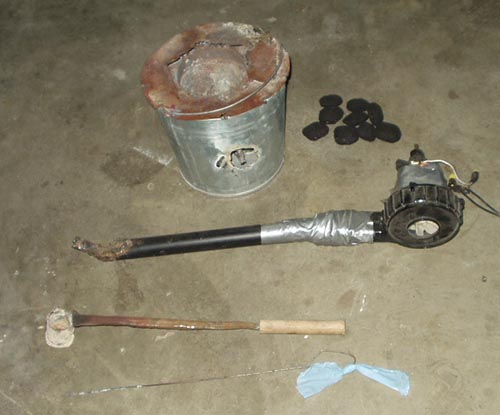
This furnace was my very first foray into metalcasting. I built it as the first welding I did with my first arc welder (a Campbell Hausfeld 70A buzz-box), so the welds are terrible.
The furnace was fired with briquette charcoal and supplied air (yes, through that tiny tube) with the pictured vacuum cleaner blower. The only thing that kept it from being a charcoal-powered cutting lance instead of a furnace is that the tube carrying the air leaks horribly.
The only insulation this furnace had is the dead airspace between the inner and outer shells. Even so, it managed to melt brass (sort of--without flux, all the zinc burnt out to make a big mess) once. I also used it to forge the ends of some steel pieces into shape for welding into a wood rack, which was my first experience forging. (I'll quit saying 'first' in a minute, I promise.)
After building my next furnace, this one sat on the shelf for a very long time, until I demolished it in the summer of 2008 to use its cast iron pump housing as scrap for my very first iron melt. A fitting end, I think, to such a historic furnace.
The Flowerpot Furnace
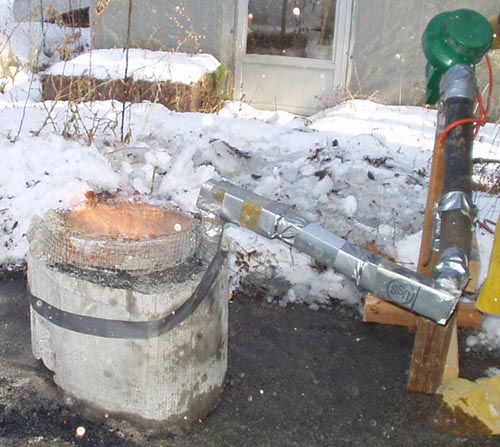
This was my second furnace, also fired by briquette charcoal. It's a 320-lb monstrosity of 6" thick concrete, which is not exactly the design intent of the original flowerpot furnace. It also doesn't have a lid. This poor efficiency showed, as it took a third of a bag of charcoal just to melt a few pounds of aluminum. I did lots of lost foam work with this furnace in late 2004 and most of 2005, until other furnaces replaced it. It was eventually smashed up into much smaller pieces and disposed of. (Random fact: My forum signature for a long time has been "The process of turning stumbling blocks into stepping stones can at times require the use of a large sledgehammer." When I came up with that, I had the destruction of this furnace in mind.)
The only reason this furnace actually works is that charcoal has wonderful self-insulating properties--i.e. the temperature in the air blast can be much higher than the temperature next to the walls. Otherwise, the flowerpot would have melted. Also, the poor insulation properties of Portland cement helped to keep the walls sufficiently cool. Needless to say, this is not a good way to build a furnace.
One thing I did get right is the air blast--it came up through the center hole in the bottom of the flowerpot, which happens to be a very effective place for it to heat the crucible quickly and evenly. Volume of blast was controlled by cycling the leafblower on and off. There's actually an air duct cast into the concrete that runs into the bottom of the furnace, which functions as a primitive intake-air preheater (though I doubt it did much to improve efficiency).
Note also that the ductwork isn't part of the original design. I had to add it after the plastic end of the leafblower started to melt one time.
The Big Furnace
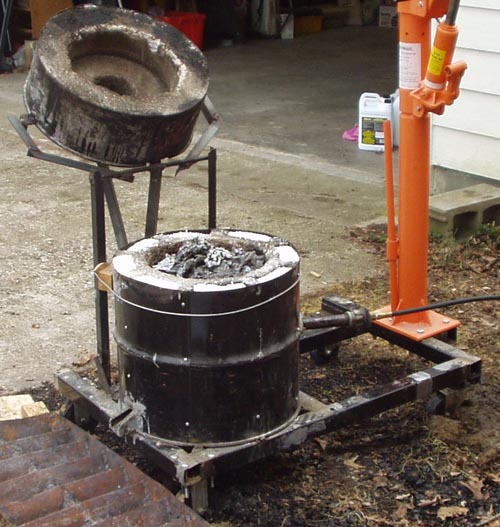
I built this furnace in the spring of 2006, but never got around to using it until almost a year later, because I built it bigger than I was prepared to handle. It was originally designed to be fired with an oilburner, which I never got working satisfactorially, so I converted it to propane. The walls are dense commercial refractory, over an inch thick to stand up to direct-melting scrap (what I'm doing in the picture), so it takes a long time and a lot of fuel to get hot. Behind that is loose perlite backfill.
The furnace is a monster by backyard standards, with a 12" bore. The outside container is a 30-gallon drum. It can handle a steel crucible with a capacity of 40 lbs of aluminum, or (just barely) a #20 A commercial crucible. The big orange thing is a 1-ton hydraulic crane meant to be mounted on pickup trucks, which is used to pull the heavy crucibles. I've also pressed it into service to roll heavy greensand molds (casting 40 pounds of aluminum at once requires a 300-lb to 500-lb mold), and to hoist my mill onto its stand.
In addition to being a crucible furnace, it's also designed to process scrap directly, and it can be used as a kiln fairly effectively, though the firing is much less even than in a purpose-made kiln.
This furnace is still in service.
The Perlite Furnace
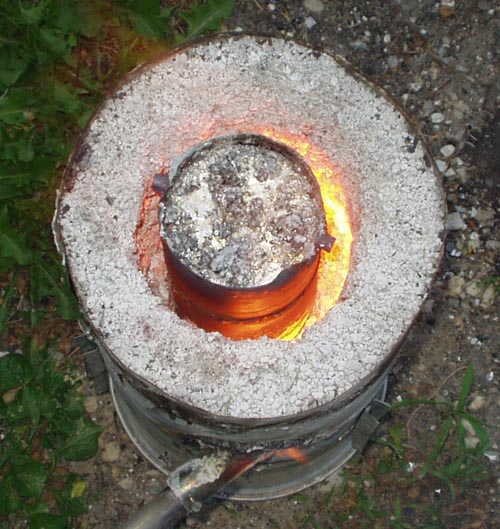
Having learned my lessons about thermal mass and insulation with my big furnace, I built this much smaller furnace as a practical everyday melter in the summer of 2006. The walls are made with 1 part commercial refractory (leftovers from the big furnace) to 3 parts perlite. This composition is a very good insulator, but is mechanically fragile and melts at higher temperatures. This was my first furnace designed specifically for propane, and it saw the debut of the disposable 1-lb propane-cylinder crucibles (which hold about 5 lbs of aluminum apiece), a very good idea which I've continued to use to this day. This furnace does have a lid, it's just not in the picture.
This furnace survived for probably a hundred melts before it was finally replaced by my next furnace. The inside grew more and more damaged from glazing produced by melting bronze and from mechanical damage by careless tools and crucibles. I repaired the area around the burner several times with molding sand before finally giving up on it. Sometime after its retirement, the furnace was finally destroyed when I used it to preheat an investment mold. The mold cracked, and when I poured the bronze in, it flooded the bottom of the furnace (which never had a drain hole). The ten pounds of bronze in the bottom was worth a lot more than the old ratty furnace was, so I destroyed it to retrieve the metal.
This furnace marked the start of my greensand casting. As a matter of fact, I poured almost nothing but sandcastings with this furnace, and I never poured sandcastings with my first two furnaces. (Remember, I started using this furnace before I started using my big furnace.)
The Spiral Furnace
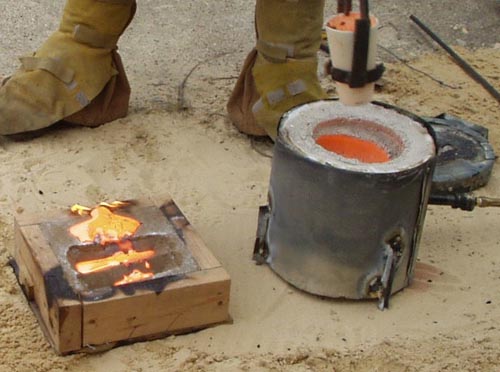
This furnace is built with 1 1/2" ceramic wool on the outside and for the lid, surrounding a molded "hotface" made of 2 parts kaolin clay, 1 part silica flour, and 7 parts foam. This recipe, while very insulative, isn't durable enough for a hotface. I also learned later that the silica reduces its thermal shock resistance because of its weird crystal behavior.
This furnace lasted for about 50 melts between fall 2007 and summer 2008, including my first successful bronze and iron melts. (I had attempted bronze in the perlite furnace, but in a steel crucible, which deformed when I tried to pour.) The furnace met its end when a crucible full of iron got a big chunk of steel dumped in it (always sort scrap carefully), freezing the melt, cracking the crucible, and dumping molten iron in the bottom. The drain hole was too small (only 1/2" dia.) and froze, allowing the furnace to fill up.
The spiral design is supposed to increase fuel efficiency. It distributed heat more evenly, but did not produce a measurable efficiency gain, and it takes up a lot of space inside the furnace, so I won't be using it in the future.
Future Furnaces
I still haven't replaced the spiral furnace, since I've been working on my kiln and related projects almost continuously since the furnace failed, and the start of college has put all my hobby projects temporarily on hold, but my plans are to make a pair of furnaces of similar size, both insulated with the 2" thick high-temp ceramic fiber left over from my kiln. One will be an electric melter for clean aluminum melts for a lower cost than propane, and the other will be an ultra-high-temp propane-fired furnace, possibly with regenerative heat exchanger, specifically designed for melting bronze, iron, and maybe stainless steel. The hotfaces and assorted hardware will be some type of mullite, fired in my kiln.
